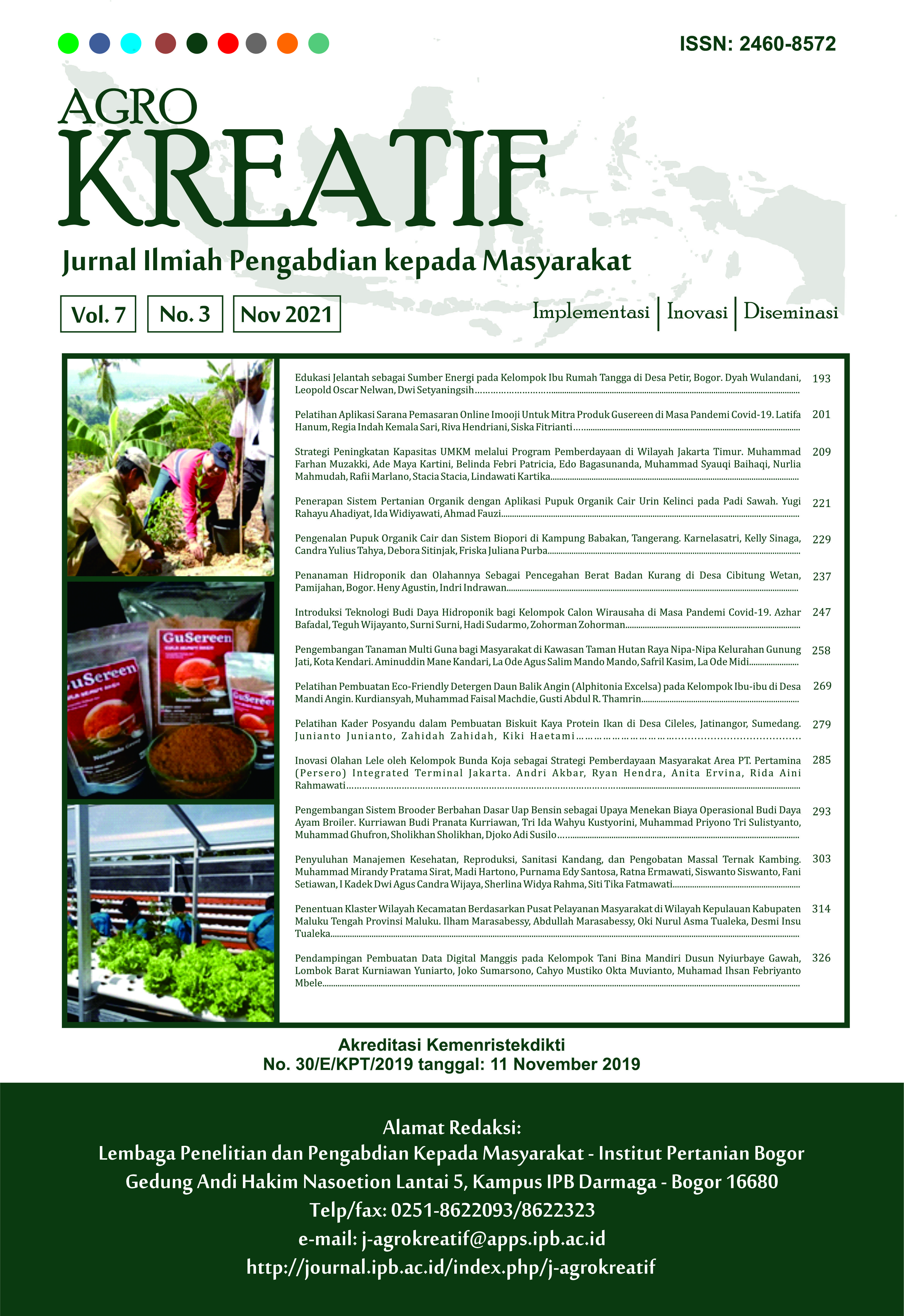Penanaman Hidroponik dan Olahannya Sebagai Pencegahan Berat Badan Kurang di Desa Cibitung Wetan, Pamijahan, Bogor
Abstract
Trilogi University with the community ‘Kampung Ramah Lingkungan’ (KRL) Seroja Kahuripan have conducted underweight prevention services in Cibitung Wetan Village, Pamijahan, Bogor. This service activity aims to educate importance of nutritious food, train in creating greenhouses and hydroponic installations, cultivate vegetable crops and their processing to increase the food value as prevention of underweight. The method was carried out in several stages: 1) The preparation and coordination; 2) Implementation; and 3) monitoring and evaluation. Based on the data, it was known that 13,69% of children aged 0–23 months are observed with underweight with body weight far below the standard and 34,44% of children are approaching as underweight. Efforts to prevent underweight were carried out by strengthening the identity of partners, the construction of greenhouse and hydroponic installation as well as training in vegetable cultivation carried out by the team so that partners can be independent in providing nutritious food. The yields of vegetables and their processed products in form of nuggets and jerky have provided food value added increasement to partners. As a result, increasement in the number of partner members from 15 to 54 people, the formation of a group logo as identity reinforcement, the construction of greenhouse facilities and hydroponic installations series, increasement of partner’s knowledges and skills in hydroponic cultivation and crops processing, and increasement partner’s awareness of underweight issue. The results of partner’s satisfaction questionnaire showed that 85% were very satisfied with the program and they hoped for sustainable and further fostering.
Downloads
References
Agustin H, Ichniarsyah AN. 2018. Efektivitas KNO3 terhadap pertumbuhan dan kandungan vitamin C kale. Jurnal Agrin. 22(1): 46–55. https://doi.org/10.20884/1.agrin.2018.22.1.458
Agustin H, Setiawan R, Puspitasari AK. 2020. Pengembangan bank sampah terkomputerisasi di Desa Cibitung Wetan Bogor. Jurnal Kumawula. 3(2): 140–153. https://doi.org/10.24198/kumawula.v3i2.24771
Gashgari R, Alharbi K, Mughrbil K, Jan A, Glolam A. 2018. Comparison between growing plants in hydroponic system and soil based system. In: Proceedings of the 4th World Congress on Mechanical, Chemical, and Material Engineering (MCM'18). Madrid, Spain: Paper No. ICMIE 131. https://doi.org/10.11159/icmie18.131
Hasanah LN & Fitriani RJ. 2020. Daya terima dan kandungan gizi naget lele (Clarias gariepinus) dengan susbtitusi modified cassava flour (mocaf) sebagai alternatif kudapan tinggi protein untuk balita. Jurnal 2-TRIK: Tunas-Tunas Riset Kesehatan. 10(2): 80–85.
Hellosehat. 2017. Apakah Tanaman Hidroponik Lebih Sehat dari Sayur Biasa? [Internet]. [diunduh 24 Agustus 2019]. Terdapat pada: https://hellosehat.com/hidup-sehat/fakta-unik/apakah-sayuran-hidroponik-lebih-sehat/.
Jati DK, Nindya TS. 2017. Asupan energi dan protein berhubungan dengan gizi kurang pada anak usia 6–24 bulan. Amerta Nutrition. 124–132. https://doi.org/10.20473/amnt.v1i2.6234.
Karima K, Achadi EL. 2012. Status gizi ibu dan berat badan lahir bayi. Jurnal Kesehatan Masyarakat Nasional. 7(3): 111–119. https://doi.org/10.21109/kesmas.v7i3.57
Kementrian Kesehatan. 2018. Buku Saku Pemantauan Status Gizi (PSG) 2017. [Internet]. [diunduh 30 Agustus 2021]. Terdapat pada: https://kesmas.kemkes.go.id/ assets/uploads/contents/others/Buku-Saku-Nasional-PSG-2017_975.pdf.
Peraturan Menteri Kesehatan Republik Indonesia No 28 Tahun 2019. 2019. [Internet]. [diunduh 30 Agustus 2021]. Terdapat pada: https://peraturan.bpk.go.id/Home/Details/138621/permenkes-no-28-tahun-2019.
Permaesih D, Rosmalina Y, Christijani R, Martuti S, Herman S. 2000. Status gizi balita di Kabupaten Bogor pada krisis ekonomi. Penelitian Gizi dan Makanan. 23: 18–24.
Pujiastuti N. 2016. Korelasi antara status gizi ibu menyusui dengan kecukupan asi di Posyandu Desa Karang Kedawang Kecamatan Sooko Kabupaten Mojokerto. Jurnal Keperawatan. 1(20): 126–137. https://doi.org/10.22219/jk.v1i2.407
Roidah. 2014. Pemanfaatan lahan dengan menggunakan sistem hidroponik. Jurnal Universitas Tulungagung BONOROWO. 1(2): 43–49.
Ruindungan RY, Kundre R, Masi GNM. 2017. Hubungan pemeriksaan antenatal care (anc) dengan kejadian berat badan lahir rendah (bblr) di wilayah kerja RSUD Tobelo. Jurnal Keperawatan. 5(1): 1–8.
Surat Keputusan Menteri Kementrian Kesehatan. 2010. Keputusan Menteri Kesehatan Republik Indonesia Nomor 1995/Menkes/SK/XII/2010 tentang standar antropometri penilaian status gizi anak. Jakarta: Direktorat Bina Gizi.
Suryathi NW, Resiani NMD. 2017. Increasing household revenues through hydroponic agricultural as sustainable agricultural efforts. Sustainable Environment Agricultural Science (SEAS). 1(2): 69–75. https://doi.org/10.22225/seas.1.2.401.69-75
Van Laack RLJM. 1999. The Role of Proteins in Water-Holding Capacity of Meat. Department of Food Science and Technology University of Tennessee, Knoxville. Plenum Publishers, New York (UK). https://doi.org/10.1007/978-1-4615-4731-0_21
This work is licensed under a Creative Commons Attribution-NonCommercial 4.0 International License.



















